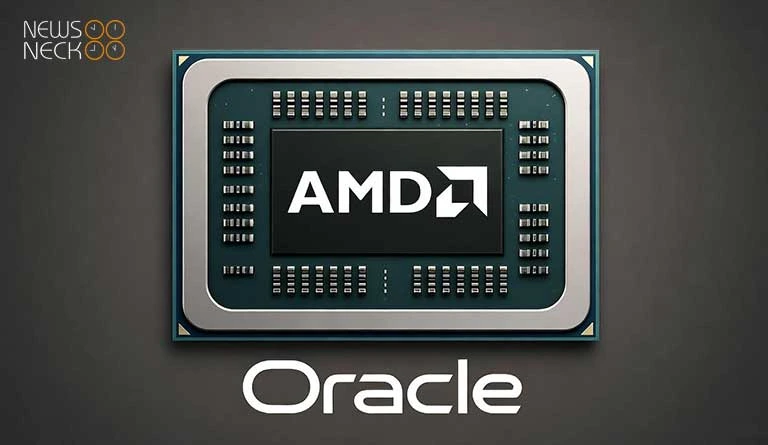The AI Chip Wars Have a New Front. The Battlefield Is the Cloud.
If you want to understand the future of artificial intelligence, you have to look beyond the software and the large language models. You have to look at the engine room at the specialized computer chips that make the magic happen. For years, that engine room has had a single, dominant foreman: Nvidia.
But a new announcement suggests that the era of single company dominance may be coming to an end. On Tuesday, Oracle’s cloud division announced it will deploy 50,000 of Advanced Micro Devices’ (AMD) most advanced AI graphics processors, starting in the second half of 2026.
This is more than just a large purchase order. It is the latest and one of the clearest signals that the world’s biggest cloud companies are actively building an alternative to Nvidia’s market-leading technology. For Oracle, AMD, and the entire AI industry, this represents a calculated bet on a different kind of future one that is more open, more competitive, and less reliant on a single provider.
The Building Blocks of a New AI Ecosystem
The heart of this new deal is a piece of hardware called the AMD Instinct MI450. This isn’t just an incremental upgrade. It represents a new level of capability for AMD. These are the company’s first AI chips that can be assembled into a larger, rack-sized system, allowing 72 individual chips to work together as a single, massively powerful computer. This kind of scale is not a luxury for modern AI; it is a necessity for creating and deploying the most advanced algorithms.
Oracle’s plan to integrate these chips is part of a broader strategy to build what it calls a “zettascale AI Supercluster”. This ambitious project, powered by AMD’s open, rack-scale AI infrastructure, is designed to eventually scale up to an almost unimaginable 131,072 GPUs, all working in concert.
For customers, this technical prowess translates into tangible benefits. The MI450 chips offer nearly triple the throughput of the previous generation and a massive 288 GB of ultra-fast memory, which is critical for handling the largest AI models. As Karan Batta, a senior vice president at Oracle Cloud Infrastructure, put it, “We feel like customers are going to take up AMD very, very well especially in the inferencing space” that is, the space where AI models are put to work on everyday tasks.
A Web of Alliances and a Shift in Power
The Oracle-AMD deal does not exist in a vacuum. It is the latest move in a complex and high-stakes chess game being played across the tech industry. Just last week, AMD secured a multi-billion-dollar partnership with OpenAI, the creator of ChatGPT, which itself has a separate $300 billion cloud deal with Oracle.
This web of partnerships reveals a crucial truth: even the biggest AI companies are no longer comfortable relying on a single chip supplier. OpenAI, whose technology was famously built using Nvidia chips, is now actively diversifying its sources of computing power. The company is also exploring designing its own AI chips in partnership with Broadcom.
This strategic shift is a direct challenge to Nvidia, which currently holds over 90% of the market for data center GPUs. The market reacted precisely to this new reality. On the day of the announcement, AMD’s shares inched higher, while Nvidia’s fell more than 3%. It was a small but telling sign of changing tides.
You Might Like it: WhatsApp’s New Facebook Link Feature Raises Privacy Concer.
The Bigger Picture: A Fight for the Future of Computing
To view this deal as merely a business rivalry is to miss its larger significance. The concentration of power in the AI supply chain is not just a market-share issue; it is a foundational one. When a single company controls the core technology that powers a transformative new industry, it holds immense influence over the pace, direction, and accessibility of innovation.
Oracle’s big bet on AMD is, therefore, a bet on a more distributed and competitive future. It is an attempt to create a viable, high-performance alternative that gives businesses a choice. This aligns with a broader industry push towards open standards and ecosystems, which stands in contrast to Nvidia’s more vertically integrated approach.
The move has been welcomed by other industry players. As Daniel Newman, CEO of The Futurum Group, noted, “Oracle has already shown it is willing to place big bets and go all in to meet the AI moment”.
Of course, a announcement is not the same as a proven, deployed technology. The first AMD MI450 chips are not scheduled to become available in Oracle’s data centers until the second half of 2026. Nvidia is not standing still, as evidenced by its own recent announcements of deepened collaborations, including one with Oracle on sovereign AI initiatives for governments like Abu Dhabi.
Yet, the path forward is now clearer. The AI revolution, which has so far been built largely on one type of hardware, is branching out. The deal between Oracle and AMD is a powerful signal that the industry is seeking a new balance of power. In the high-stakes race to define the future of intelligence, competition for the engine room is just beginning.
Author: Yasir Khan
Date: 14 Oct, 2025
For More Updates, Visit Newsneck













